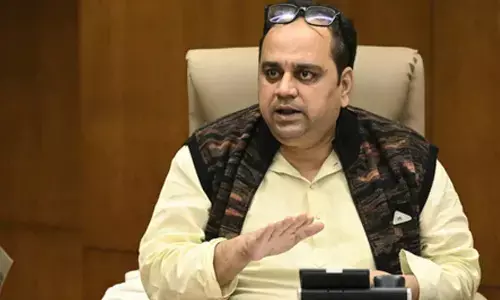How can India create more employment?

The current glimmers of hope on the jobs front will only turn into a sustained uptrend if policies and procedures are altered to make them much more business-friendly
There is finally a glimmer of good news on the jobs front, an area that has caused deep concern over the past few years. Despite claims of India being the world's fastest growing economy, the slow pace of job creation has led to fears that the youthful population dividend was going to remain an untapped potential. Fortunately, the tide seems to be turning, slowly but surely, judging by latest data both from the government and private agencies. It shows that employment is not only growing but has been rising gradually even from the crucial pandemic year 2020-21.
The periodic labour force survey for 2020-21 released by the Ministry of Statistics and Programme Implementation shows that the country's unemployment rate fell to 4.2 per cent from 4.8 per cent in the previous year. It was 6.1 per cent in 2017-18 and 5.8 per cent in 2018-19. According to the report, even the labour force participation rate (LFPR) rose to 41.6 per cent from 40.6 per cent in the previous year. This has been on the back of a spurt in the female labour force participation to 25.1 per cen99t from 22.8 per cent in the previous year.
The official data comes even as employment research agency, Centre for Monitoring Indian Economy (CMIE) has given possibly its most upbeat outlook on jobs ever since the pandemic began in 2020. Its studies show the unemployment rate has gone down from 7.83 per cent in April to 7.12 per cent in May. It notes that employment increased from 402.9 million in April to 404 million in May, making it the second consecutive month of an increase in employment. The rise in April, however, was larger at 7 million.
While these numbers cannot be described as a sea change in the employment situation, it does indicate there is an upward trend that could possibly be deepened by government policies aimed at creating more jobs. It is no coincidence that it is just now that several initiatives have been launched in a bid to make more jobs available to the youth of the country. The critical one is the drive to open up a million government jobs simply by filling all the vacancies that currently exist in departments and ministries. It will include the Agnipath scheme - a short service commission proposal for the armed forces. This alone is expected to create over 45000 jobs in the immediate future. It is, of course, not just an employment creation programme but a measure of reform for the armed forces that have continued with the erstwhile colonial scheme of lifetime service ever since independence. While the old system will continue for the bulk of the forces, this will bring in a much-needed breath of modernity and reduce the overall age of personnel. It will also help in reducing the enormous pension bill of the defence establishment.
State governments are following the centre's lead in trying to fill up existing government vacancies. U.P. chief minister Yogi Adityanath, for instance has declared the intent to fill more than 40,000 posts in the State police department by the end of the year.
These initiatives to fill government job vacancies cannot, however, be a solution to the employment crisis. First, it has to be questioned as to whether filling up the existing job slots will lead to bloating of administrative expenses. Many of these jobs may not have been filled up for various reasons including the fact that the government has surplus manpower on its hands. Second, the scale of job creation to meet the needs of the economy is much larger than a million government posts. Such opportunities need to be in the tens of millions, if not more, to meet the aspirations of today's youth.
The solutions lie more in policies that have already been announced by the government in terms of boosting expenditure on infrastructure growth. These seem to have yielded some dividends in recent months, going by the latest CMIE report. It comments that there has been a big shift in employment from agriculture to industry and services over the last two months. Jobs in agriculture has declined by 5.2 million in April but industry added 5.5 million and services another 6.7 million, thus ensuring that net employment rose by 7 million during the month. Farm jobs fell further by 9.6 million in May but industry absorbed 10 million and services another 5,00,000. Net employment thus rose by about one million during the month.
The revival of industrial growth that has already been recorded in the recent indices of industrial production is clearly reflected in the CMIE data for the last two months. Within the ambit of industries, the construction sector accounts for a much larger share of jobs than the manufacturing sector. The incremental jobs growth recorded during these months thus was more towards construction rather than manufacturing. Yet there has been a sizable increase in the latter sector with total employment in May reaching 34 million, the highest since the pandemic but still lower than the 40 million plus level reached in October – December 2019.
Jobs in the construction industry, on the other hand, touched a peak of 72 million jobs in May, which is the highest in a long time, according to the research agency. As for services, there was an incremental rise of about 7.2 million jobs over this period, lower than for industry.
Thus the much-hyped launch of the schemes to expand the scope of governmental jobs may not yield jobs in the numbers that are needed right now. Especially when one considers the context that five million youth enter the job market every year. The focus instead should be on policies that make it easier for industry and services to operate efficiently and effectively in the country. The processes for setting up new units need to become much more investor-friendly as bureaucratic red tape continues to engulf the system. The current glimmers of hope on the jobs front will only turn into a sustained uptrend if policies and procedures are altered to make them much more business-friendly.
Woman injured in stabbing attack in Tokyo, suspect at large
Bengal cop booked for murder over mysterious death of woman home guard, SIT to probe case
Staffer recalls horror of 7-kg gold robbery by armed gang in Karnataka’s Hunsur
25-Year-Old Airline Cabin Crew Member Dies At Gurugram Party; Police Begin Investigation















